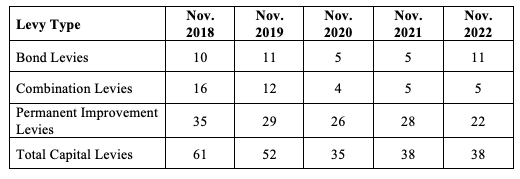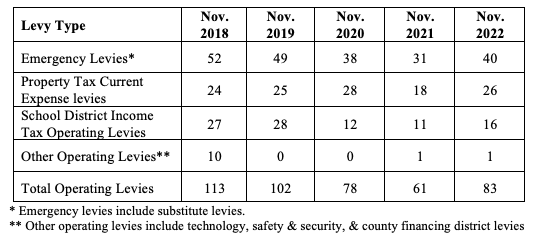This article provides a brief overview of school levies on the ballot in the November 8, 2022 general election. A complete list of local issues on the November 2022 ballot is included at the end of this article and can also be found on the Ohio Secretary of State’s website at: https://www.sos.state.oh.us/elections/voters/about-this-election/
Election results from prior years (which includes school levy data beginning in 2013) can be accessed from the Secretary of State website by selecting the year in question at: http://www.sos.state.oh.us/sos/elections/Research/electResultsMain.aspx
Table 1 provides a summary of the number and type of school levies on the ballot in Ohio’s general election over the last 5 years. Table 1 shows that the number of levies on the ballot has been roughly 25-30% lower the past 3 years than in 2018 and 2019. Of course, 2020, 2021 and 2022 reflect the years of the pandemic which may contribute to districts’ reluctance to ask voters for levy approval. The increase from 99 levies on the ballot in November 2021 to 121 levies on the ballot in 2022 may indicate that this reluctance is fading.
Table 1: School Levies on the November General Election Ballot 2018-2022, By Type

Table 2 provides a more detailed breakdown of capital levies (defined as bond levies, permanent improvement (PI) levies and combination bond/PI levies) on the ballot in Ohio’s November general election from 2018-2022. Table 2 shows that the number of capital levies on the November ballot has decreased by nearly 1/3 in 2020, 2021 and 2022 as compared to 2019, and by nearly 40% compared to 2018. The majority of capital levies are typically new levies, as bond and combination levies are always “new” since they cannot be renewed. Capital levies historically pass 60-65% of the time in Ohio.
Table 2: Capital Levies on the November General Election Ballot 2018-2022, By Type

Table 3 provides a more detailed breakdown of operating levies on the November general election ballot from 2018-2022. The data in Table 3 show that over the past 5 years emergency levies typically account for roughly 1/2 of school operating levies on the November ballot in Ohio. Note that substitute levies, which allow districts to aggregate existing emergency levies, are included in the emergency levy count. Among the other types of operating levies, the number of property tax current expenses levies in 2018 and 2019 (49) was roughly the same as the number of school district income tax (SDIT) levies (55), however, there have been nearly twice as many current expense levies (72) as SDIT levies (39) on the November ballot from 2020-2022. “Other” operating levies (defined as those for county financing districts, technology levies and school safety & security levies) have comprised only a very small share of operating levies on the ballot in recent November general elections.
Table 3: Operating Levies on the November General Election Ballot 2018-2022, By Type

Table 4 provides additional insight on operating levies placed on the November ballot in Ohio by providing a breakdown of new levies, renewal levies, and replacement levies. New levies are defined as those that are placing new millage on the ballot, renewal levies are renewing existing term-limited levies and replacement levies (which are rarely used) restore a levy to its originally voted millage level after it has been reduced by the impact of HB 920 rolling back the voted rate. Substitute levies are considered here to be emergency renewal levies.
Table 4: Operating Levies on the November General Election Ballot 2018-2022, By Type

Table 4 shows that roughly 60% of operating levies on the ballot in the November general election in 2018 were renewal levies, however, the percentage of renewals increased to nearly 75% in 2019, 2020 and 2022 and was over 80% in 2021. The percentage of school levies on the ballot that have been renewals has been steadily increasing in Ohio over the past 25 years. From 1994-1997 82% of school levies were new levies. This percentage decreased to 67% from 1998-2006, to 57.5% from 2007-2013 and to only 31% from 2014-2021. While renewal levies are more successful at the ballot (renewal levies typically pass 90% of the time while new levies have passed at roughly a 40% rate in recent years), renewal levies typically do not bring in additional tax dollars whereas new levies do.
Thus, it is the expectation here that the majority of operating levies on the November 2022 ballot will pass next month because nearly three-quarters of the levies on the ballot are renewals. While this will certainly be good news in school districts that are facing expiring levies, the increase in revenue will likely be less than if the levies were new rather than renewals
Table 5 provides a complete list of school levies on Ohio’s November 8, 2022 general election ballot.
Table 5: November 8, 2022 November General Election School Levies By Type

* “CPT” means Continuing Period of Time (i.e. an unexpiring levy)
